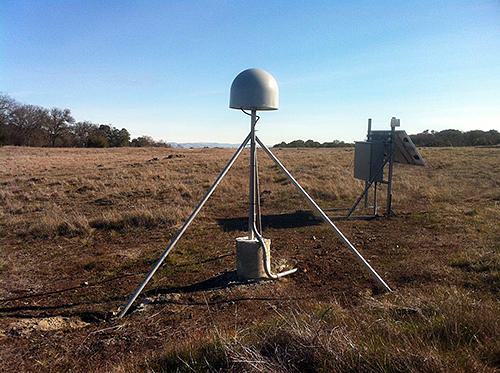Network and Internet
Outdoor Wireless Mesh Network
 In 2009, the preserve received funding from the National Science Foundation to install an outdoor wireless mesh network that extends Internet connectivity throughout Jasper Ridge. This project was funded by an award from the Improvements in Facilities, Communications, and Equipment at Biological Field Stations and Marine Laboratories (FSML) grant program.
In 2009, the preserve received funding from the National Science Foundation to install an outdoor wireless mesh network that extends Internet connectivity throughout Jasper Ridge. This project was funded by an award from the Improvements in Facilities, Communications, and Equipment at Biological Field Stations and Marine Laboratories (FSML) grant program.
Wireless mesh networks are a reliable and flexible networking solution for outdoor settings. Each node in the mesh network functions as both a wireless access point and a relay that communicates with adjacent nodes. Because of redundant links between end-user devices (such as data loggers, field computers, wireless sensors, etc.) and mesh nodes, the network can automatically reconfigure itself if a mesh node fails, preventing a loss of connectivity. New nodes can also be added to expand or change the network without interfering with existing connections. There are 25 wireless nodes located throughout the preserve. Some access points are gateway nodes with wired access to the existing Jasper Ridge and Stanford University broadband network. These gateways allow data transfer between sensors and other networked devices within the wireless network, devices used by researchers at the Sun Field Station, the Stanford University main campus, and the rest of the world.
Check out these projects using the outdoor mesh network:
- Bay Area Regional Deformation Network (BARD) Station, JRSC
- Remote Winds art installation
- Wireless digital camera traps
- PhenoCam Network camera
- JRBP weather station
- Jasper Ridge Global Change Experiment
- Jasper Ridge Eddy Flux station
- Seismic monitoring station, JRSC
- Birdcast Live Audio Stream - birds, nature sounds
Getting your project online:
- To connect to the outdoor wireless mesh network, devices must first be registered for use on the Stanford network.
- Computers and mobile phones can be self-registered.
- Most sensors or scientific devices will require manual registration by the Local Network Administrator (LNA).
- For assistance connecting to the Jasper Ridge wireless mesh network, please submit a Technology support request to the local network administrator.
Stanford wireless network - Sun Field Station
Inside the Sun Field Station, Stanford faculty, students, staff and registered affiliates can connect to the "Stanford" wireless network. A low-bandwidth Visitor network is also available. A more secure wireless network is also available and uses the "Stanford Secure" SSID. This network provides encrypted connectivity for wireless users. "Stanford Secure" requires a one-time setup to automatically configure devices to use this network. Stanford also offers an "eduroam" SSID. This network allows visitors from other colleges and universities to connect to it with the credentials of their home institution, provided that their institution also enables eduroam.
The architecture of the Stanford wireless networks makes them unsuitable for most research instrumentation applications such as IP cameras or dataloggers that require remote management.
Learn more about Stanford wireless network and services:
https://uit.stanford.edu/service/wirelessnet
Gigabit LAN - Sun Field Station
The Sun Field Station has a Gigabit (1000Mbs) network connection to the main Stanford campus network and outside world. A Local Area Network (LAN) extends connectivity to computers and other devices via standard Ethernet (RJ45) ports distributed throughout the building. The high-bandwidth connection is suitable for servers, storage, streaming media, high-volume data transfer. Users must be affiliated with Stanford to register and connect to the hard-wired Ethernet LAN.
To connect to the Sun Field Station's Local Area Network (LAN), devices must first be registered for use on the Stanford network. Computers and mobile phones can be self-registered. Most sensors or scientific devices will require manual registration by the Local Network Administrator (LNA).




